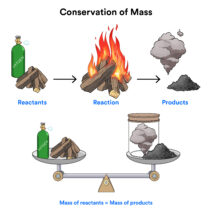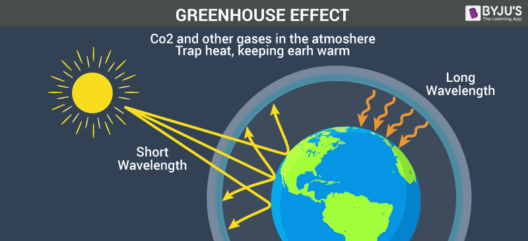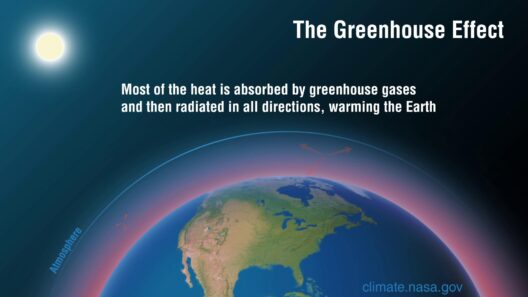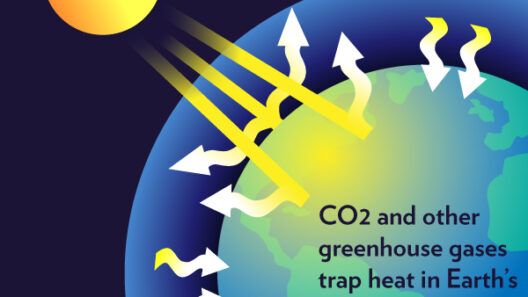The greenhouse effect is a pivotal environmental phenomenon that plays a crucial role in regulating the Earth’s climate. It encompasses a complex interplay of natural processes and human activities, ultimately determining the planet’s temperature and weather patterns. Understanding how the greenhouse effect operates is essential for addressing pressing climate concerns and fostering sustainable practices.
The greenhouse effect originates from the interaction between solar radiation and the Earth’s atmosphere. When sunlight reaches the Earth, it is either absorbed or reflected. A significant portion of this energy is absorbed by the Earth’s surface, warming it. In turn, the planet emits this energy back into the atmosphere in the form of infrared radiation. However, certain gases in the atmosphere—commonly referred to as greenhouse gases—trap some of this energy, preventing it from escaping into space. This process creates a natural greenhouse effect, which is necessary for maintaining a habitable temperature on the planet.
However, the increase in greenhouse gas emissions resulting from industrialization, deforestation, and other human activities has amplified this natural process, leading to what is commonly termed as anthropogenic climate change. It is vital to examine the mechanisms behind the greenhouse effect, the types of greenhouse gases involved, and the ramifications of an intensified greenhouse effect in order to appreciate its impact on both the environment and society at large.
Understanding the Mechanism of the Greenhouse Effect
The greenhouse effect begins with the sun, which emits energy in the form of sunlight, traveling through the vacuum of space and reaching the Earth. Once this solar energy reaches our planet, it interacts with the atmosphere and surface. Although some of the sunlight is reflected back into space, the majority is absorbed by the Earth, warming land and oceans alike. This essential heating process facilitates the existence of ecosystems and life as we know it.
As the Earth’s surface heats up, it re-emits energy in the form of infrared radiation, a form of energy that is less energetic than visible light and is characterized by longer wavelengths. This is where greenhouse gases come into play. Significant contributors include carbon dioxide (CO2), methane (CH4), nitrous oxide (N2O), and water vapor (H2O). These gases have unique properties that allow them to absorb and re-emit infrared radiation effectively. While water vapor is the most abundant greenhouse gas, carbon dioxide has a much more significant impact due to its long atmospheric lifetime and the influence of human activities on its levels.
The Role of Greenhouse Gases: Heroes or Villains?
Greenhouse gases can be likened to a blanket snugly enveloping the Earth. While they enable vital warmth, excessive amounts lead to overheating. The predominant greenhouse gases affecting our climate include:
– Carbon Dioxide (CO2): Emitted through the burning of fossil fuels, deforestation, and various industrial processes, CO2 concentrations have surged over the past century, corroborated by frequent measurement. Its impacts are far-reaching and long-lasting, making it a key player in climate change.
– Methane (CH4): A more potent greenhouse gas than CO2 but less abundant, methane is released during the production and transport of coal, oil, and natural gas. It is also emitted by livestock and other agricultural practices, as well as from organic waste decay in landfills. Its ability to trap heat is approximately 25 times greater than that of CO2 over a 100-year period.
– Nitrous Oxide (N2O): Though less prevalent, nitrous oxide has a significant warming potential and is produced by agricultural and industrial activities, as well as during the combustion of fossil fuels and solid waste. Its compound properties exacerbate its effect on the atmosphere.
– Water Vapor (H2O): As the most potent greenhouse gas, water vapor amplifies the effects of other greenhouse gases. Its concentration varies in the atmosphere and is primarily controlled by temperature. Warm air holds more water vapor, which forms clouds and contributes to weather dynamics.
The Consequences of an Intensified Greenhouse Effect
The ramifications of an augmented greenhouse effect are exceedingly dire and far-reaching. A ascension in global temperatures precipitates myriad consequences such as:
– Climate Change: The increase in average global temperatures is one of the most alarming consequences of the intensified greenhouse effect. This leads to more extreme and unpredictable weather patterns, including more intense storms, prolonged droughts, and irregular precipitation, thereby affecting ecosystems and agriculture.
– Ocean Acidification: Elevated levels of CO2 do not just warm the atmosphere but also lead to a higher concentration of carbonic acid in oceans. This acidification endangers marine life, jeopardizing coral reefs and disrupting oceanic ecosystems.
– Melting Ice Caps and Rising Sea Levels: The warming climate causes polar ice caps to melt, leading to rising sea levels. Coastal communities face increased flooding risks, which threaten livelihood, property, and biodiversity.
– Disruption of Ecosystems: Flora and fauna often struggle to adapt to rapidly changing climates and face challenges in finding suitable habitats. Species extinction rates have increased, contributing to a loss of biodiversity that can inhibit ecosystem function and resilience.
In conclusion, while the greenhouse effect is a natural and indispensable aspect of our environment, human actions have precipitated alarming changes. Understanding the mechanisms, impacts, and urgency of addressing greenhouse gas emissions is critical for making informed choices that can foster a sustainable future. Embracing renewable energy, enhancing energy efficiency, and advocating for conservation are imperative steps toward mitigating the greenhouse effect and curbing climate change. Together, these actions can help restore balance and promote the health of our planet for future generations.







